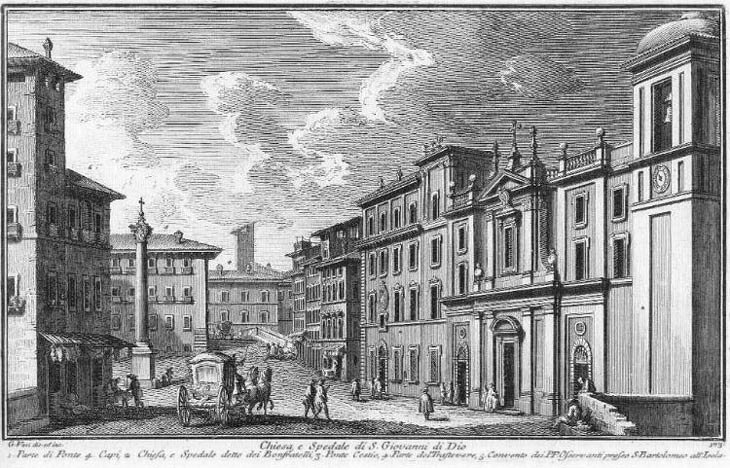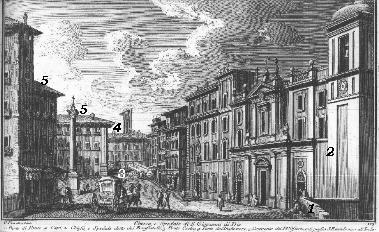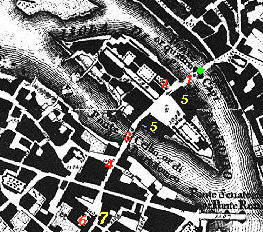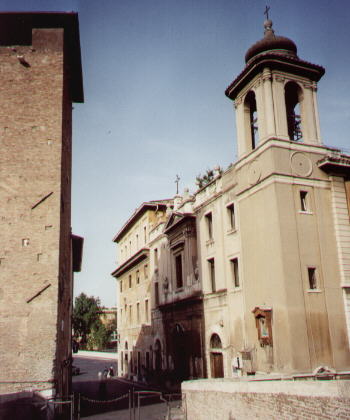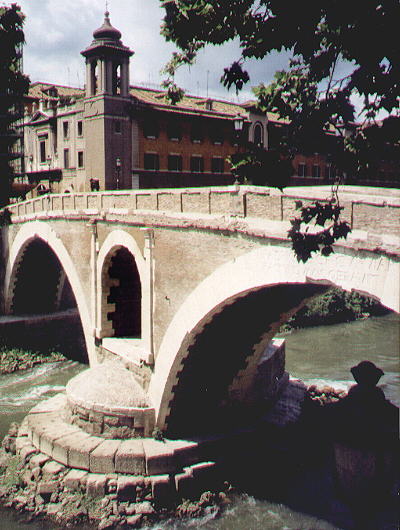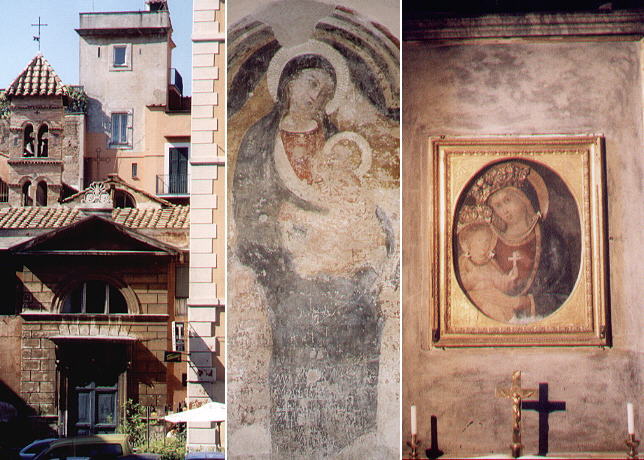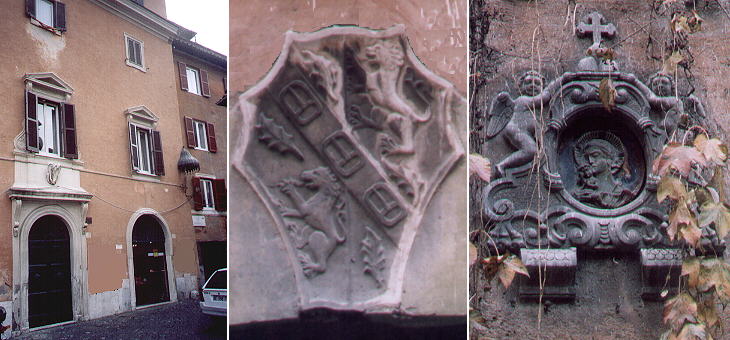

Chiesa e Spedale
di S. Giovanni di Dio (Book
9) (Map
C3) (Day 5) and (Day 6)
(View C9) (Rione Ripa) and
(Rione Trastevere)
In this page:
The plate by Giuseppe Vasi
Today's view
A view from the Bridge
S. Benedetto in Piscinula
Casa di Sir John Leslie
The Plate (No. 173)
This view is taken from Ponte
Quattro Capi (green dot in the 1748 map below) and it shows the short and narrow street which crosses
Isola Tiberina. To the left the Monastery of S.
Bartolomeo all'Isola. In the description below the plate Vasi made reference to: 1) Ponte Quattro Capi;
2) Spedale di S. Giovanni di Dio o de' Bonfratelli (Fatebenefratelli);
3) Ponte Cestio;
4) Part of Trastevere; 5) Parts of the Monastery adjoining S. Bartolomeo all'Isola.
1), 3) and 5) are shown in other pages. The map shows also 6) S. Benedetto in Piscinula; 7) Casa di Sir John Leslie.
Today
Part of the buildings close to Ponte Cestio have been demolished,
whilst the part of them near Ponte Quattro Capi have not been altered.
The island devoted to Aesculapius, retains this memory in the Hospital
still existing of S. Giovanni di Dio dei Fate Bene Fratelli.
A view from the Bridge
A recent restoration of Ponte Quattro Capi brought back the coat
of arms of Innocentius XI celebrating his action to preserve the old bridge
(in the background the four-headed figure on the balustrade).
S. Benedetto
in Piscinula
Ponte Cestio leads to the very old church of S. Benedetto in Piscinula,
where the Saint lived and where according to Vasi he used to pray before the framed sacred image shown above. The fašade
was modified in the XIXth century. The church has the smallest bell tower of Rome and some XIIIth century frescoes.
Casa di Sir John Leslie
The coat of arms of the owner of this finely restored old house near S. Benedetto in
Piscinula, would puzzle even an expert in genealogy and heraldry of the Roman families. The meaning of the
horses and the three buckles requires a visit to Castle Leslie in
Ireland. The following is an excerpt from the owners' website:
"The Leslies can trace there ancestry back to Attila The Hun. Bartholomew Leslie was the chamberlain and protector of Margaret
Queen Of Scotland. It is through him that the family motto Grip Fast originated.
While fleeing enemies Queen Margaret rode pillion on the back of Bartholomew's horse.
When fording a river the queen fell off, Bartholomew threw her the end of his belt and told her to grip fast the buckle.
He saved the Queen's life & from that day forward she bestowed the motto Grip Fast on the Leslies.
The first Leslie to come to Ireland was Bishop John Leslie who was Bishop of the Isles of Scotland.
In 1665 Glaslough Castle and Demesne was sold by Sir Thomas Ridgeway to the Bishop of Clogher John Leslie.
... the poetic Sir Shane transferred the property to his eldest son John Norman Leslie who became the
4th Baronet. Owing to ill health from five years in a prisoner of war camp he made the estate over to his sister Anita and lived
the next 40 years in Rome until his return home to Castle Leslie in 1994 where he still lives."
Sir John Leslie embellished his Roman residence by adding a couple of modern madonnelle.
Excerpts from Giuseppe Vasi 1761 Itinerary related to this page:
Chiesa di s. Giovanni Calibita, e spedale de' Benfratelli
Nel sito di questa chiesa aveva la sua casa il s. Titolare, la quale essendo poi convertita
in chiesa, da prima fu unita ad un monastero di monache; ma essendo queste trasferite
presso s. Anna de' Funari, fu questa con il convento conceduta ai religiosi spedalieri
di s. Giovanni di Dio, dati i Benfratelli, i quali vi eressero lo spedale per li
poveri civili e nobili. Quindi volendo nell'anno 1600. rinnovare la chiesa, trovarono
alcuni corpi di Santi, fra' quali quello del s. Titolare con altre reliquie e poi
nell'anno 1742. fu ornata di marmi, stucchi dorati, e pitture assai vaghe. Il quadro
sull' altare maggiore Ŕ di Andrea Generelli detto il Sabinese, e i laterali sono di
Corrado Giaquinto, il quale ha fatto tutte le pitture a fresco nella volta, ed anco
il quadro di s. Antonio nell'altare a destra. Nel convento evvi la nativitÓ del
Signore creduta opera di Raffaelle da Urbino.
Chiesa di s. Benedetto in Piscinula
Quanto antica e divota, altrettanto sguarnita, e mal ridotta Ŕ questa chiesa, sebbene sia parrocchiale.
Fu eretta nell'estremitÓ del palazzo della antichissima famiglia Anicia, in cui dimor˛ s. Benedetto mentre
era giovinetto, e vi Ŕ tradizione, che l'immagine della ss. Vergine, che si conserva in una cappelletta
posta nel piccolo portico di questa chiesa, sia quell'istessa, avanti alla quale il santo Giovinetto spesso
orava; perci˛ fu dipoi al medesimo s. Benedetto dedicata, la quale dall' antico nome della vicina
piazzetta, si dice in Piscivola.
|
Next plate in Book 9: Spedale
di S. Gallicano
Next step in Day 5 itinerary: Chiesa di S.
Bartolomeo
Next step in Day 6 itinerary: Chiesa di S.
S. Andrea dei Vascellari
You have completed your tour of Rione Ripa!

Go
to  or to Book
9 or to my Home
Page on Baroque Rome or to my Home Page on Rome
in the footsteps of an XVIIIth century traveller.
or to Book
9 or to my Home
Page on Baroque Rome or to my Home Page on Rome
in the footsteps of an XVIIIth century traveller.
|


